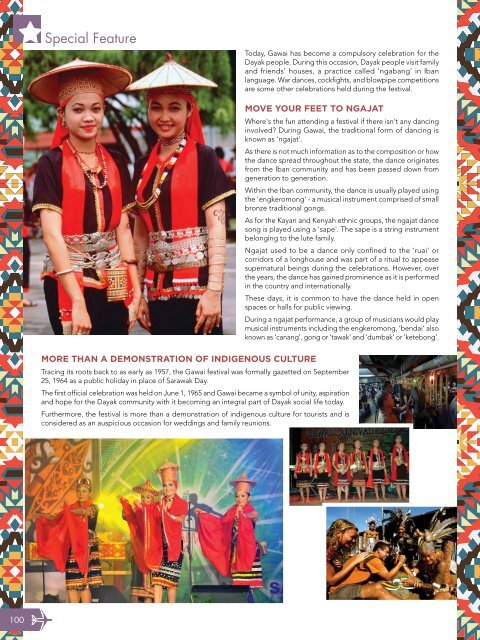CONVERGENCE MAY - JUNE 2016
Malaysias' Airport Magazine
Malaysias' Airport Magazine
You also want an ePaper? Increase the reach of your titles
YUMPU automatically turns print PDFs into web optimized ePapers that Google loves.
Special Feature<br />
Today, Gawai has become a compulsory celebration for the<br />
Dayak people. During this occasion, Dayak people visit family<br />
and friends’ houses, a practice called ‘ngabang’ in Iban<br />
language. War dances, cockfights, and blowpipe competitions<br />
are some other celebrations held during the festival.<br />
Move your feet to Ngajat<br />
Where's the fun attending a festival if there isn't any dancing<br />
involved? During Gawai, the traditional form of dancing is<br />
known as 'ngajat'.<br />
As there is not much information as to the composition or how<br />
the dance spread throughout the state, the dance originates<br />
from the Iban community and has been passed down from<br />
generation to generation.<br />
Within the Iban community, the dance is usually played using<br />
the 'engkeromong' - a musical instrument comprised of small<br />
bronze traditional gongs.<br />
As for the Kayan and Kenyah ethnic groups, the ngajat dance<br />
song is played using a 'sape'. The sape is a string instrument<br />
belonging to the lute family.<br />
Ngajat used to be a dance only confined to the 'ruai' or<br />
corridors of a longhouse and was part of a ritual to appease<br />
supernatural beings during the celebrations. However, over<br />
the years, the dance has gained prominence as it is performed<br />
in the country and internationally.<br />
These days, it is common to have the dance held in open<br />
spaces or halls for public viewing.<br />
During a ngajat performance, a group of musicians would play<br />
musical instruments including the engkeromong, ‘bendai’ also<br />
known as ‘canang’, gong or ‘tawak’ and ‘dumbak’ or ‘ketebong’.<br />
More than a demonstration of indigenous culture<br />
Tracing its roots back to as early as 1957, the Gawai festival was formally gazetted on September<br />
25, 1964 as a public holiday in place of Sarawak Day.<br />
The first official celebration was held on June 1, 1965 and Gawai became a symbol of unity, aspiration<br />
and hope for the Dayak community with it becoming an integral part of Dayak social life today.<br />
Furthermore, the festival is more than a demonstration of indigenous culture for tourists and is<br />
considered as an auspicious occasion for weddings and family reunions.<br />
100

















